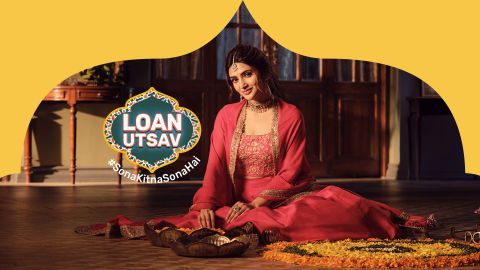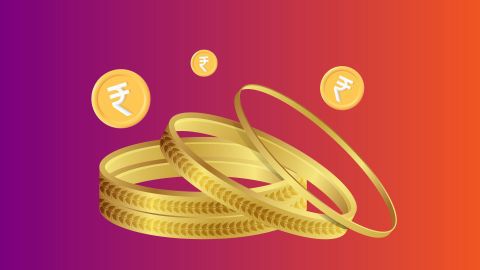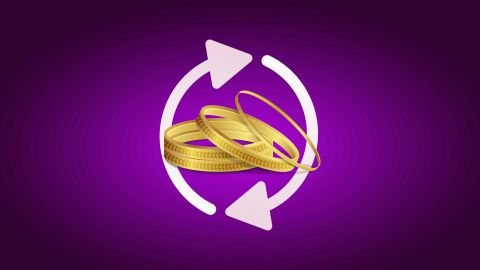2 mins
10 December 2024
Green gold is a term used in different contexts, referring either to environmentally responsible gold mining or a unique alloy of gold. In the former context, it denotes gold sourced sustainably, minimising environmental damage and promoting ethical practices. In its alloyed form, green gold refers to a naturally green-hued metal created by mixing gold with specific metals. Understanding green gold's types and its significance helps us appreciate its role in sustainability and financial applications like gold loans.
Why is it called green gold?
The term "green gold" derives from its unique characteristics and symbolism. When referring to sustainably sourced gold, "green" represents eco-friendliness and ethical practices, aligning with the global push for environmentally responsible mining. In its alloyed form, the name comes from its greenish hue, achieved by mixing gold with metals like silver or cadmium. This unique colour sets it apart in jewellery and design. Both interpretations of green gold reflect the modern demand for sustainability, innovation, and aesthetics, making it a valued option for conscious consumers and industries.
Green gold’s role in the gold loan market highlights its relevance in promoting sustainability without compromising financial utility.
Types of green gold: Natural and artificial
Green gold is available in two forms: natural and artificial. Natural green gold refers to the gold alloy’s unique hue achieved by combining gold with metals like silver, which imparts a subtle green tint. It is primarily used in jewellery for its aesthetic appeal. Artificial green gold, on the other hand, refers to gold sourced through eco-friendly mining practices that minimise environmental damage and uphold ethical standards. While natural green gold focuses on unique design elements, artificial green gold aligns with sustainable development goals, catering to a growing demand for responsible sourcing. Both types play distinct roles in gold’s modern applications.The role of green gold in sustainable development
Green gold plays a vital role in sustainable development by addressing the environmental and ethical challenges of traditional gold mining. Eco-friendly practices in sourcing green gold reduce deforestation, water pollution, and habitat destruction, ensuring minimal ecological damage. Ethical sourcing standards, including fair wages and safe working conditions for miners, promote social sustainability. By aligning with global environmental goals, green gold supports industries and consumers in reducing their carbon footprint. Its application in jewellery, technology, and investments offers a sustainable alternative to conventional gold, encouraging responsible consumption. Green gold exemplifies the integration of economic growth with environmental preservation, making it a cornerstone of sustainability.Impact of green gold on gold loan
| Aspect | Impact of green gold on gold loan |
| Valuation | Sustainably sourced gold holds similar market value to traditional gold, ensuring eligibility for loans. |
| Certification Requirements | Gold loans for green gold may require proof of ethical sourcing or hallmarking. |
| Market Appeal | Growing demand for green gold may enhance its resale value, benefiting loan applicants. |
| Consumer Preference | Eco-conscious borrowers prefer green gold for its sustainability, aligning with ethical values. |
| Transparency in Loan Terms | Bajaj Finance ensures transparent valuation for green gold, considering its ethical and market significance. |
Green gold’s role in the gold loan market highlights its relevance in promoting sustainability without compromising financial utility.
Frequently asked questions
What is green gold?
Green gold refers to either a gold alloy with a greenish hue or gold sourced sustainably. As an alloy, it combines gold with metals like silver or cadmium to achieve its unique colour. As sustainably sourced gold, it represents ethically mined gold that adheres to eco-friendly practices and supports fair labour conditions. Green gold is valued for its aesthetic appeal and its alignment with ethical and environmental principles.
What are the common uses of green gold?
Green gold is commonly used in jewellery for its distinctive greenish hue, adding a unique aesthetic to ornaments. It is also utilised in environmentally conscious industries where sustainably sourced gold is preferred. Green gold features in decorative items, bespoke designs, and luxury products. Additionally, its ethical sourcing makes it appealing for use in investments and eco-friendly technology, catering to consumers and industries prioritising sustainability and innovation.
Is green gold cheaper than normal gold?
No, green gold is not typically cheaper than normal gold. The alloy form of green gold, created by mixing gold with metals like silver, can vary in price depending on purity and composition. Sustainably sourced green gold often commands a premium due to the ethical practices involved in its mining. Both types retain significant value due to their unique attributes and growing demand in jewellery and environmentally conscious markets.
Where do we find green gold?
Green gold can be found in two forms. The alloy form is created in specialised jewellery manufacturing facilities by combining gold with metals like silver. Sustainably sourced green gold comes from certified eco-friendly mines worldwide, adhering to ethical and environmental standards. These sources ensure minimal environmental impact and fair labour conditions. Green gold, in both forms, is available in jewellery markets and through ethical gold suppliers catering to environmentally conscious buyers.
Show More
Show Less
Bajaj Finserv App for All Your Financial Needs and Goals
Trusted by 50 million+ customers in India, Bajaj Finserv App is a one-stop solution for all your financial needs and goals.
You can use the Bajaj Finserv App to:
Apply for loans online, such as Instant Personal Loan, Home Loan, Business Loan, Gold Loan, and more.
You can use the Bajaj Finserv App to:
Apply for loans online, such as Instant Personal Loan, Home Loan, Business Loan, Gold Loan, and more.
- Explore and apply for co-branded credit cards online.
- Invest in fixed deposits and mutual funds on the app.
- Choose from multiple insurance for your health, motor and even pocket insurance, from various insurance providers.
- Pay and manage your bills and recharges using the BBPS platform. Use Bajaj Pay and Bajaj Wallet for quick and simple money transfers and transactions.
- Apply for Insta EMI Card and get a pre-approved limit on the app. Explore over 1 million products on the app that can be purchased from a partner store on Easy EMIs.
- Shop from over 100+ brand partners that offer a diverse range of products and services.
- Use specialised tools like EMI calculators, SIP Calculators
- Check your credit score, download loan statements, and even get quick customer support—all on the app.






